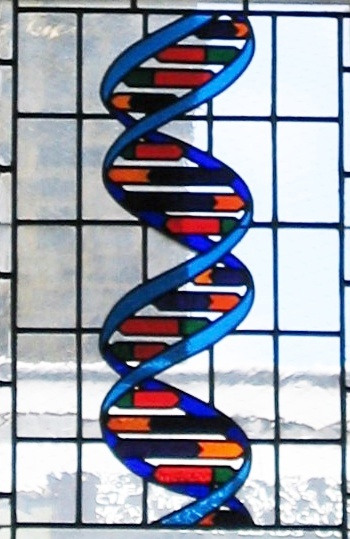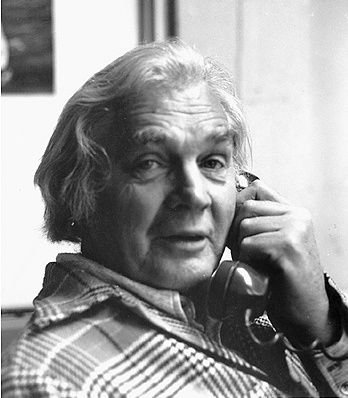Roy Britten and "Junk" DNA
February 27, 2012
As any
computer engineer or
computer scientist knows, the
information content in a
data stream is not a hundred percent. If you look at
asynchronous serial communication, as implemented in the venerable
RS-232 serial standard, your eight
bits of data are enclosed in one or two start bits and a stop bit.
Percentage-wise, the useful data is just 72.7 - 80%, and things get worse if you include a
parity bit, or
error correction bits; or, some
control codes, such as
ACK/NAC (which always reminds me of dialog from an
Itchy & Scratchy cartoon). All such bits are not wasted. They're necessary to keep things
synchronized.
The same principle may be operative in the
genetic material,
DNA, to ensure its error-free duplication. There are long stretches of DNA that don't encode for
proteins. Since these sequences don't appear to have a
biological function, they're sometimes called "
junk DNA," and they often appear in the middle of functioning
genes. Although non-coding, they may, as in my serial protocol example, help to align the
DNA strands.
The amount of junk DNA varies between
species, but, percentage-wise, it can be considerable. Although human DNA contains about three billion
base pairs, it's surprising how few genes humans have. It was always thought that such a complex organism must be specified by many genes, but the
Human Genome Project proved that assumption wrong.
There was a contest organized by geneticists in 2000 to guess the number of genes that would be found by the Human Genome Project. The contest, called GeneSweep, got estimates higher than 150,000 genes from those who believed that most of DNA coded for genes. Although an exact count is still elusive, information on May, 2003, marked the winner as the geneticist with the lowest estimate, 25,947.[1] That's some rather compact source code to fully describe a human.

Life as Art
Stained glass window representation of DNA at Gonville and Caius College, Cambridge, where Francis Crick was a PhD student.
Crick insisted that the window be visible from the inside, only, so the DNA would not be seen to coil the wrong way.
(Via Wikimedia Commons))
One important transformation that occurred in
molecular biology at the end of
World War II was the number of
physicists who entered the field.
Francis Crick, half of the famous
Watson & Crick duo who discovered the structure of DNA and its method of replication, is one example of this. Crick had started with a
Ph.D. dissertation topic on the
viscosity of
water at high
temperatures, but this was interrupted by the war. Crick migrated to molecular biology after the war.
One other physicist who made this transition was the
American molecular biologist,
Roy John Britten, who died on January 21, 2012, at age 92.[2-6] Britten and
David Kohne, his colleague at the
Carnegie Institution of Washington, were the ones who discovered the non-genetic, junk DNA.

Roy Britten
Britten was associated with Caltech from 1971 until his death.
Later generations of students might inquire about the unusual cellphone he's holding to his ear.
(Image Courtesy of Caltech, used with permission))
Britten was a
prodigy, attending the
University of Virginia in
physics at age 16. He received his
bachelor's degree in 1940, and then went to work on the
Manhattan Project, where he attempted to do
uranium isotope separation magnetically.[3] He continued in graduate school at
Princeton University after the war, doing a dissertation on the "Scattering of 32 MeV Protons from Several Elements." After getting his Ph.D. in
nuclear physics from Princeton in 1951, Britten jumped into
biophysics at the Carnegie Institution.
Britten was a staff member of the
Department of Terrestrial Magnetism at Carnegie from 1951 to 1971, as a member of its biophysics group.[3] After attending a
bacteriophage course at
Cold Spring Harbor Laboratory, Britten's interest shifted to
genetics; specifically, the mechanism by which genetic information becomes
proteins. The transition was enabled by the department's collegial and interdisciplinary atmosphere.[3]
In 1971, while still with Carnegie, Britten began a collaboration with developmental biologist,
Eric Davidson, at
Caltech. The collaboration was so fruitful that he asked his Carnegie director if he could remain at Caltech, but still be associated with the Carnegie Institution. Until his designation as a Caltech
Emeritus Professor in 1991, Britten remained a "Staff Member, Carnegie Institution of Washington."[3]
Britten and Kohne discovered non-coding DNA using a technique called renaturation. The technique involves breaking DNA into smaller segments, and then separating these into single single strands of DNA. The complementary strands will recombine, and they will recombine faster when there's more repetition.
Materials scientists (and
dentists) will be interested to learn that
hydroxyapatite, Ca
10(PO
4)
6(OH)
2, is used to separate double-stranded DNA from single-stranded DNA for analysis.[6]
Britten and Davidson advanced
evolutionary developmental biology (often called, "evo-devo," which always reminds me of the
eponymous music group) by showing that the development of organisms wasn't just about genes. It was also about the regulation of gene expression. There are regulatory genes that determine when and where other genes are expressed.[5]
Roy Britten was elected to the
National Academy of Sciences in 1972.
Maxine F. Singer, a former Carnegie Institution President, remarked that "Roy was a scientists’ scientist."[3]
References:
- How Many Genes Are in the Human Genome? U.S. Department of Energy Office of Science, Office of Biological and Environmental Research, Human Genome Program.
- Terrestrial Magnetism's Roy Britten dies at 92, Carnegie Institution Web Site, January 31, 2012.
- Janice Dunlap, "Roy J. Britten's Years at DTM," Carnegie Institution Web Site, February 1, 2012.
- Roy Britten, Caltech's pioneering DNA researcher, dies at 92, Pasadena Star News, January 26, 2012.
- Marcus Woo, "Roy J. Britten, 92," Caltech Press Release, January 26, 2012.
- Thomas H. Maugh II, "Roy Britten dies at 92; Caltech biologist was DNA, gene pioneer," Los Angeles Times, February 22, 2012.
Permanent Link to this article
Linked Keywords: Computer engineer; computer scientist; information content; data stream; asynchronous serial communication; RS-232 serial standard; bits of data; parity bit; error correction bits; control codes; ACK/NAC; Itchy & Scratchy cartoon; synchronized; genetic; DNA; protein; biological; junk DNA; gene; DNA strand; species; base pair; Human Genome Project; Gonville and Caius College, Cambridge; Francis Crick; Wikimedia Commons; molecular biology; World War II; physicist; Francis Crick; James D. Watson; Ph.D. dissertation; viscosity; water; temperature; American; Roy John Britten; David Kohne; Carnegie Institution of Washington; cellphone; prodigy; University of Virginia; physics; bachelor's degree; Manhattan Project; uranium; electromagnetic isotope separation; Princeton University; nuclear physics; biophysics; Department of Terrestrial Magnetism; bacteriophage; Cold Spring Harbor Laboratory; genetics; protein; Eric Davidson; Caltech; Emeritus; materials scientist; dentist; hydroxyapatite; evolutionary developmental biology; Devo music group; National Academy of Sciences; Maxine F. Singer.